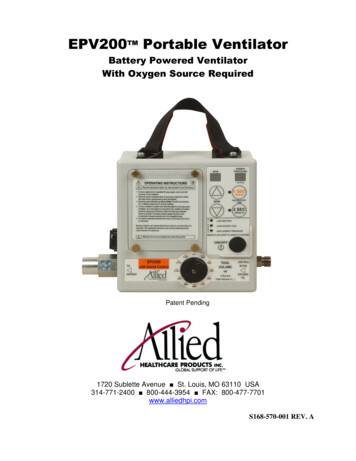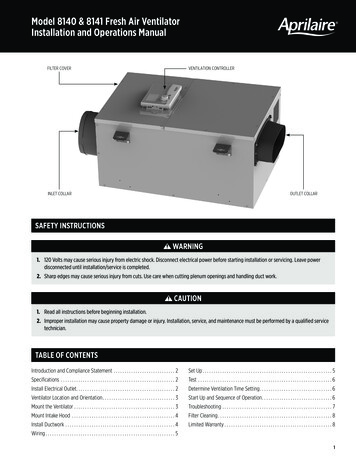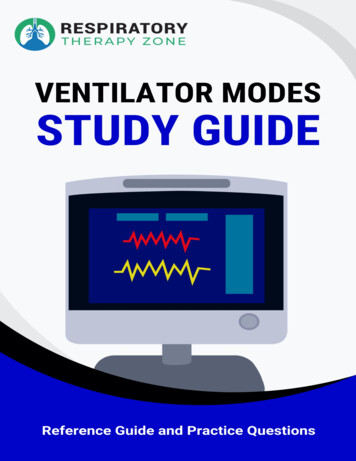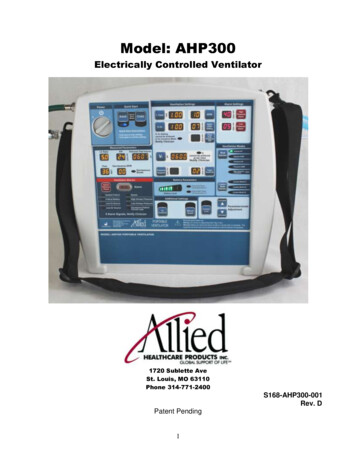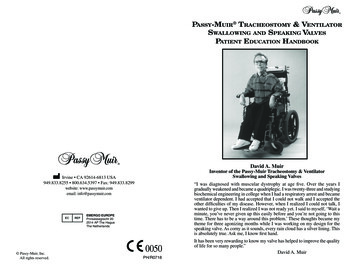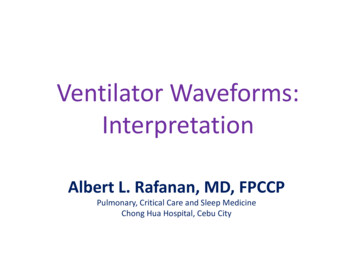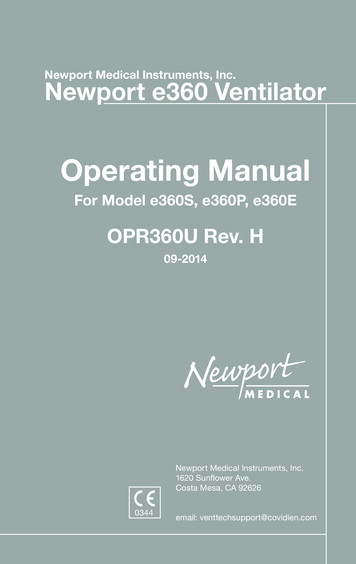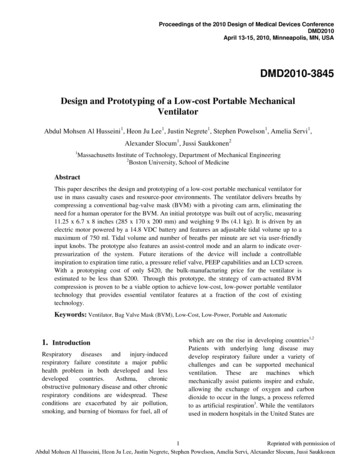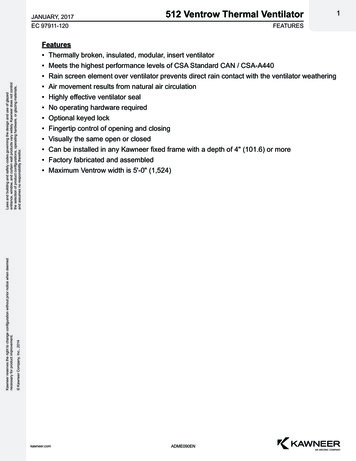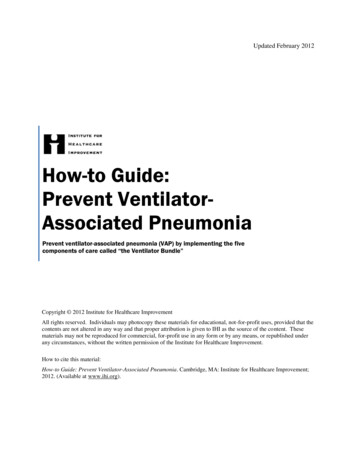
Transcription
Updated February 2012How-to Guide:Prevent VentilatorAssociated PneumoniaPrevent ventilator-associated pneumonia (VAP) by implementing the fivecomponents of care called “the Ventilator Bundle”Copyright 2012 Institute for Healthcare ImprovementAll rights reserved. Individuals may photocopy these materials for educational, not-for-profit uses, provided that thecontents are not altered in any way and that proper attribution is given to IHI as the source of the content. Thesematerials may not be reproduced for commercial, for-profit use in any form or by any means, or republished underany circumstances, without the written permission of the Institute for Healthcare Improvement.How to cite this material:How-to Guide: Prevent Ventilator-Associated Pneumonia. Cambridge, MA: Institute for Healthcare Improvement;2012. (Available at www.ihi.org).
Institute for Healthcare ImprovementContentsIntroduction . 3What is the Institute for Healthcare Improvement (IHI)? . 3What is a How-to Guide?. 3Contributors . 4Development of the Ventilator Bundle . 5Defining the Problem . 7The Case for Preventing Ventilator-Associated Pneumonia . 8Potential Impact of the Ventilator Bundle . 9Preventing Ventilator-Associated Pneumonia: Five Components of Care . 101. Elevation of the Head of the Bed . 102. Daily Sedative Interruption and Daily Assessment of Readiness to Extubate . 123. Peptic Ulcer Disease (PUD) Prophylaxis. 154. Deep Venous Thrombosis (DVT) Prophylaxis . 175. Daily Oral Care with Chlorhexidine . 18Forming the Team . 20Setting Aims . 21Using the Model for Improvement . 22PDSA Worksheet . 23Getting Started . 25First Test of Change . 26Measurement . 27Track Measures Over Time . 28Barriers That May Be Encountered . 29Work to Achieve a High Level of Compliance . 30Tips for Gathering Data. 30Tips and Tricks: Ventilator-Associated Pneumonia . 31Frequently Asked Questions: Ventilator-Associated Pneumonia. 33What You Need to Know about VAP: A Fact Sheet for Patients and Their Family Members . 37Appendix A: Sample Tools . 39Appendix B: Recommended Intervention-Level Measures . 44Process Measure(s) . 44Outcome Measure(s) . 45Alignment with Other Measure Sets . 452
How-to Guide: Prevent Ventilator-Associated PneumoniaIntroductionWhat is the Institute for Healthcare Improvement (IHI)?The Institute for Healthcare Improvement (IHI) is a not-for-profit organization leading the improvementof health care throughout the world. IHI helps accelerate change by cultivating promising concepts forimproving patient care and turning those ideas into action. Thousands of health care providers participatein IHI’s groundbreaking work.What is a How-to Guide?IHI’s How-to Guides address specific health care interventions hospitals and/or entire health systems canpursue to improve the quality of health care while reducing unnecessary death, medical error, and cost.These interventions align with several national initiatives of the Institute of Medicine (IOM), Agency forHealthcare Research and Quality (AHRQ), Centers for Medicare and Medicaid Services (CMS), JointCommission, Centers for Disease Control and Prevention (CDC), as well as the Department of Health andHuman Services’ ―Partnership for Patients‖ initiative.This material was first developed for the IHI 5 Million Lives Campaign, a voluntary initiative to protectpatients from five million incidents of medical harm (December 2006 to December 2008). The 5 MillionLives Campaign was built on the 2004-2006 IHI 100,000 Lives Campaign. Both Campaigns involvedthousands of hospitals and communities from around the United States in specific interventions. ―MentorHospitals‖ showed marked improvement in one or more of the Campaign interventions and volunteered toteach other hospitals. Many of their successful implementation stories and data have been included in thisHow-to Guide.5 Million Lives Campaign Donors100,000 Lives Campaign DonorsBlue Cross and Blue Shield health plansBlue Cross Blue Shield of MassachusettsCardinal Health FoundationCardinal Health FoundationBlue Shield of California FoundationRx FoundationRx FoundationGordon and Betty Moore FoundationAetna FoundationThe Colorado TrustBaxter International, Inc.Blue Shield of California FoundationThe Colorado TrustRobert Wood Johnson FoundationAbbott Point-of-CareBaxter International, Inc.The Leeds FamilyDavid Calkins Memorial Fund3
Institute for Healthcare ImprovementContributorsThe work of leading organizations has informed the development of this guide. These include NationalPressure Ulcer Advisory Panel (NPUAP), Ascension Health, Advancing Excellence in America's NursingHomes, the New Jersey Hospital Association (NJHA), OSF St. Francis Medical Center, and OwensboroMedical Health System.4
How-to Guide: Prevent Ventilator-Associated PneumoniaDevelopment of the Ventilator BundleIn early 2001, IHI collaborated with VHA in the Idealized Design of the Intensive Care Unit (IDICU). Agroup of faculty including intensivists and improvement leaders convened to determine improvementpriorities for large-scale ICU redesign and worked with 13 participating ICUs. Care of ventilated patientswas identified as a top priority, as this population experiences high levels of mortality and morbidity. Inaddition, all recognized the importance of teamwork and communication among members of the ICU careteam as an essential component in providing excellent patient care and improving outcomes.Ventilator patients are at high risk for several serious complications: ventilator-associated pneumonia(VAP), venous thromboembolism (VTE), and stress-induced gastrointestinal bleeding. Faculty reviewedthe evidence and identified four elements of care for prevention of these events in vented patients that aresupported by solid level-one trials: Elevation of the head of the bed (HOB) to between 30 and 45 degrees. Daily ―sedative interruption‖ and daily assessment of readiness to extubate. Peptic ulcer disease (PUD) prophylaxis. Deep venous thrombosis (DVT) prophylaxis (unless contraindicated).In the spring of 2010, IHI faculty determined that there is support in the evidence for the addition of afifth element in this work: Daily oral care with chlorhexidine.Faculty found that that overall application of these elements was not occurring reliably. Moving to the―all-or-nothing‖ measure changed the focus of the improvement effort to a goal of improving all four ofthe initial elements together, which became known as the IHI Ventilator Bundle. When hospital teamsbegan to shift their improvement efforts from reliability of individual elements to reliability of the bundle(all-or-nothing approach), new ways of working were needed that incorporated reliability principles fromother industries.A surprising result was that ventilator-associated pneumonia (VAP) rates in these ICUs began to decreasedramatically, followed by several ICUs experiencing consecutive months of no VAPs. Faculty and teamsspeculated—and have confirmed in many cases—that it was the new emphasis on working reliably and asa more coordinated care team that caused VAP rates to decrease, particularly since only two of those fourelements of care related directly to VAP prevention.In general, care bundles are groupings of best practices with respect to a disease process that individuallyimprove care, but when applied together may result in substantially greater improvement. The coreelements of the bundle are evidence-based strategies that may prevent or reduce risk of thesecomplications, and the bundle is an effort to design a standard approach to delivering these core elementsof care.5
Institute for Healthcare ImprovementNot all possible therapies are included in a particular bundle, as the bundle is not intended to be acomprehensive list of all care that should be provided. For example, several interventions— subglotticsuctioning, selective decontamination of the gut, and continuous lateral rotation—are not included in theIHI Ventilator Bundle. This does not imply that these and other activities should not be considered forvented patients as VAP prevention strategies. Because the Ventilator Bundle as designed has led tosuccess in many hospitals, IHI elected not to alter the elements until the spring of 2010 with the additionof daily oral care with chlorhexidine. However, many hospitals had already added items to the bundle ontheir own and the Ventilator Bundle in Scotland has included oral care since 2009. It is important toensure that any elements of care added to the bundle are supported by solid level-one evidence and thatthe bundle does not get ―too large‖ or it becomes more difficult to measure and manage. Care bundleswork best when the number of elements is small.Many hospitals have since implemented the Ventilator Bundle in their ICUs and have reported significantdecreases in VAPs or long periods of time (one year, two years, or longer) with no VAPs in thesepatients. As a result of these successes, we recommend implementation of the Ventilator Bundle forpreventing VAP.6
How-to Guide: Prevent Ventilator-Associated PneumoniaDefining the ProblemVentilator-associated pneumonia (VAP) is a nosocomial lung infection that occurs in patients receivingmechanical ventilation and for whom the infection was not the reason for ventilation (i.e., the infectioncommenced after ventilation). VAP is identified according to the Centers for Disease Control andPrevention (CDC) definition by using a combination of radiologic, clinical, and laboratory criteria(NHSN Manual: Patient Safety Component Protocols) and is usually suspected when a patient onmechanical ventilation develops a new or progressive pulmonary infiltrate with fever, leukocytosis, andpurulent tracheobronchial secretions. Pneumonia is considered as ventilator associated if the patient wasintubated and ventilated at the time or within 48 hours before the onset of infection. The CDC definitionnotes, ―There is no minimum period of time that the ventilator must be in place in order for the PNEU[sic] to be considered ventilator-associated.‖ (NHSN Manual: Patient Safety Component Protocols, p.15.)Definition and criteria should be reviewed locally, in consultation with internal experts such as infectiondisease experts and physicians who care for ventilated patients (typically pulmonologists/intensivists).Hospitals treat different populations in their intensive care units and will thus be measuring VAP indifferent types of patients. For example, trauma centers may include vented trauma patients, which not allhospitals have, and some hospitals include long-term ventilator patients in their ICUs while others do not.Attempts to benchmark performance will depend largely upon the definition that hospitals adhere to intheir diagnostic strategies and the populations treated. This does not mean that there is no such entity asventilator-associated pneumonia or that clinicians cannot improve upon the care that they deliver topatients at risk for developing pneumonia. Once a definition is settled upon at an institutional level byinvolved personnel, performance improvement can be gauged with respect to prevention as long as thatstandard is applied regularly.1,2,3,4,51Meduri GU. Diagnosis and differential diagnosis of ventilator-associated pneumonia. Clin Chest Med. 1995;16(1):61-93.2Fagon JY, Chastre J, Hance AJ, et al. Evaluation of clinical judgment in the identification and treatment of nosocomialpneumonia in ventilated patients. Chest. 1993;103(2):547-553.3Fabregas N, Ewig S, Torres A, et al. Clinical diagnosis of ventilator-associated pneumonia revisited: Comparative validationusing immediate post-mortem lung biopsies. Thorax. 1999;54(1):867-873.4Chastre J, Fagon JY. Ventilator-associated pneumonia. Am J Respir Crit Care Med. 2002;165(7):867-903.5Niederman MS, Torres A, Summer W. Invasive diagnostic testing is not needed routinely to manage suspected ventilatorassociated pneumonia. Am J Respir Crit Care Med. 1994;150(2):565-569.7
Institute for Healthcare ImprovementThe Case for Preventing Ventilator-Associated PneumoniaPreventing pneumonia of any kind is certainly a laudable goal. However, there are some reasons to beparticularly concerned about the impact of pneumonia associated with ventilator use. VAP is the leading cause of death among hospital-acquired infections, exceeding the rate of deathdue to central line infections, severe sepsis, and respiratory tract infections in the non-intubatedpatient. Perhaps the most concerning aspect of VAP is the high rate of associated mortality.Hospital mortality of ventilated patients who develop VAP is 46%, compared to 32% forventilated patients who do not develop VAP.6 In addition, VAP prolongs time spent onthe ventilator, length of ICU stay, andlength of hospital stay after discharge fromthe ICU.7 Strikingly, VAP adds an estimated cost of 40,000 to a typical hospital admission.8An Example from Bloomington Hospital Bloomington, INCost savings:Before implementation of the Ventilator Bundle,our hospital was averaging 8 VAP/year in ourA recent Compendium of Strategies tomedical/surgical unit. Since the implementationPrevent Healthcare-Associated Infectionsof this work, we had no VAPs from Septemberin Acute Care Hospitals published by2005 - April 2008. We had 1 VAP in 2008 and 1SHEA-IDSA (in partnership with The JointVAP in 2009. Using an estimate of 40,000/VAP,Commission, Association for Professionalsthe hospital has saved 1.2 million from Januaryin Infection Control and Epidemiology, and2006 - December 2009 in the medical/surgicalthe American Hospital Association)ICU alone.emphasizes the importance of reducingthese infections and includes a guideline of practice recommendations to address them.96Ibrahim EH, Tracy L, Hill C, et al. The occurrence of ventilator-associated pneumonia in a community hospital: Risk factorsand clinical outcomes. Chest. 2001;20(2):555-561.7Rello J, Ollendorf DA, Oster G, et al. VAP Outcomes Scientific Advisory Group. Epidemiology and outcomes of ventilatorassociated pneumonia in a large US database. Chest. 2002;22(6):2115-2121.8Tablan OC, Anderson LJ, Besser R, et al. CDC; Healthcare Infection Control Practices Advisory Committee. Guidelines forpreventing health-care-associated pneumonia, 2003: Recommendations of CDC and the Healthcare Infection Control PracticesAdvisory Committee. MMWR Recomm Rep. 2004;53(RR-3):1-36.9Yokoe DS, Mermel LA, Classen, D, et al. A compendium of strategies to prevent healthcare-associated infections in acute carehospitals. Infect Control Hosp Epidemiol. 2008; 29:S12-S21.8
How-to Guide: Prevent Ventilator-Associated PneumoniaPotential Impact of the Ventilator BundleApplying IHI’s Ventilator Bundle in the care of ventilated patients can markedly reduce the incidence ofVAP. We have observed an average 45% reduction in the incidence of VAP in a prior ICU collaborativeimprovement project at IHI. Moreover, there is a trend toward greater success among teams that complyfully with the elements of the bundle. That is, teams that unfailingly implement every bundle element onevery patient, every time, have gone months without a single case of pneumonia associated with theventilator. In the IHI 100,000 Lives Campaign, over 30 hospitals reported more than one year of data withno VAP in their measured population (n.b., not all hospitals reporting measured the same population dueto local differences in patients).The reasons for the success are most likely due to the effect of the underlying interventions, as well as tothe teamwork that is developed while carrying out the required care reliably. With regard to specificinterventions, consider that in a randomized controlled trial of 86 intubated patients on mechanicalventilation assigned to semi-recumbent (45 degrees) or supine position, there were 18% fewer confirmedcases of VAP (p 0.018).10In another study, Kress et al. conducted a randomized controlled trial in 128 adults on mechanicalventilation and demonstrated that for patients whose sedation was interrupted daily until the patient wasawake, as compared to patients whose sedation was interrupted only at the clinician’s discretion, theduration of ventilation was decreased from 7.3 days to 4.9 days (p 0.004).11These findings and others have contributed to the construction of the Ventilator Bundle and to its successin preventing VAP.10Drakulovic MB, Torres A, Bauer TT, et al. Supine body position as a risk factor for nosocomial pneumonia in mechanicallyventilated patients: A randomised trial. Lancet. 1999;354(9193):1851-1858.11Kress JP, Pohlman AS, O'Connor MF, et al. Daily interruption of sedative infusions in critically ill patients undergoingmechanical ventilation. N Engl J Med. 2000;342(20):1471-1477.9
Institute for Healthcare ImprovementPreventing Ventilator-Associated Pneumonia:Five Components of Care1. Elevation of the Head of the BedElevation of the head of the bed is an integral part of the Ventilator Bundle and has been correlated withreduction in the rate of ventilator-associated pneumonia. The recommended elevation is between 30 and45 degrees.Drakulovic et al. conducted a randomized controlled trial in 86 mechanically ventilated patients assignedto semi-recumbent or supine body position. The trial demonstrated that suspected cases of ventilatorassociated pneumonia had an incidence of 34%, while in the semi-recumbent position suspected cases hadan incidence of 8% (p 0.003). Similarly, confirmed cases were 23% and 5% respectively (p 0.018).12While it is not immediately clear whether the intervention aids in the prevention of ventilator-associatedpneumonia by decreasing the risk of aspiration of gastrointestinal contents or oropharyngeal andnasopharyngeal secretions, this was the ostensible reason for the initial recommendation.Another reason that the intervention was suggested was to improve patients’ ventilation. For example,patients in the supine position will have lower spontaneous tidal volumes on pressure support ventilationthan those seated in an upright position. Although patients may be on mandatory modes of ventilation, theimprovement in position may aid ventilatory efforts and minimize atelectasis.Some concerns with regard to this position have included patients sliding down in bed and, if skinintegrity is compromised, shearing of skin. Others have commented on the possibility of patientdiscomfort. Although it is difficult to assess for these concerns in a controlled manner, anecdotalexperience is that neither has been a complaint of care from providers or from patients, once they are offthe ventilator and able to speak.Another randomized controlled trial was completed in the Netherlands that challenged the feasibility ofkeeping the head of the bed elevated in mechanically ventilated patients. While the purported benefitswere not directly challenged, there was great evidence to suggest that keeping the head of the bed at 45degrees is a more challenging task than would be otherwise imagined. This work underscores thedifficulty of keeping the head of the bed elevated and the low reliability with which care teams have beenable to maintain this standard under routine conditions.1312Drakulovic MB, Torres A, Bauer TT, Nicolas JM, Nogue S, Ferrer M. Supine body position as a risk factor for nosocomialpneumonia in mechanically ventilated patients: A randomised trial. Lancet. Nov 27 1999;354(9193):1851-1858.13van Nieuwenhoven CA, Vandenbroucke-Grauls C, van Tiel FH, et al. Feasibility and effects of the semirecumbent position toprevent ventilator-associated pneumonia: A randomized study. Crit Care Med. 2006 Feb;34(2):396-402.10
How-to Guide: Prevent Ventilator-Associated PneumoniaWhat changes can we make that will result in improvement?Hospital teams across the United States have developed and tested process and system changes thatallowed them to improve performance on elevation of the head of the bed. These measures, takentogether, support the implementation of the Ventilator Bundle. Some of these changes are: Implement a mechanism to ensure head-of-the-bed elevation, such as including this interventionon nursing flow sheets and as a topic at multidisciplinary rounds. Create an environment where respiratory therapists work collaboratively with nursing to maintainhead-of-the-bed elevation. Involve families in the process by educating them about the importance of head-of-the-bedelevation and encourage them to notify clinical personnel when the bed does not appear to be inthe proper position. Use visual cues so it is easy to identify when the bed is in the proper position, such as a line onthe wall that can only be seen if the bed is below a 30-degree angle. Include this intervention on order sets for initiation and weaning of mechanical ventilation,delivery of tube feedings, and provision of oral care. Post compliance with the intervention in a prominent place in your ICU to encourage change andmotivate staff.11
Institute for Healthcare Improvement2. Daily Sedative Interruption and Daily Assessment of Readiness to ExtubateUsing daily sedative interruptions and assessing the patient’s readiness to extubate are an integral part ofthe Ventilator Bundle and have been correlated with reduction in the rate of ventilator-associatedpneumonia.Kress et al. conducted a randomized controlled trial in 128 adult mechanically ventilated patientsreceiving continuous infusion of sedative agents in a medical intensive care unit. Patients wererandomized to receive daily interruption of sedation until awake versus management at the clinician’sdiscretion. Daily interruption resulted in a highly significant reduction in time spent on mechanicalventilation. The duration of mechanical ventilation decreased from 7.3 days to 4.9 days (p 0.004).In the trial, an investigator interrupted the sedation each day until the patients were awake and couldfollow instructions or until they became uncomfortable or agitated and were deemed to require theresumption of sedation. A nurse evaluated the patients each day throughout the period when infusionswere stopped until the patients were either awake or uncomfortable and in need of resumed sedation. Thisnurse immediately contacted a study physician when a patient awakened, at which time the studyphysician examined the patient and decided whether to resume the infusions. The sedative infusions werestarted again after the patient was awake or, if agitation prevented successful waking, at half the previousrates and were adjusted according to the need for sedation. For complete details as well as handlingspecial circumstances such as use of paralytic agents, please refer to the actual trial.14Based on this study, it appears that lightening sedation decreases the amount of time spent on mechanicalventilation and therefore the risk of ventilator-associated pneumonia. In addition, weaning patients fromventilators becomes easier when patients are able to assist themselves at extubation with coughing andcontrol of secretions.Sedative interruptions are not without certain risks, however. For instance, there is a fear that patientswho are not deeply sedated may have an increased potential for self-extubation. With experiencehowever, this has not been shown to be the case; in fact, intubated patients randomized to be treated withno sedation did not have an increased rate of unplanned extubations.15 In addition, some have suggestedthat there may be an increased potential for pain and anxiety associated with lightening sedation. Lastly,increased tone and poor synchrony with the ventilator during the maneuver may risk episodes ofdesaturation.Despite these concerns, a comparison of patients receiving sedation interruption versus those patientswhose sedation was managed at a clinician’s discretion demonstrates that patients receiving sedationinterruption exhibit fewer overall complications. The Kress study data were reviewed in a post-hoc14Kress JP, Pohlman AS, O'Connor MF, Hall JB. Daily interruption of sedative infusions in critically ill patients undergoingmechanical ventilation. N Engl J Med. 2000;342(20):1471-1477.15Thomas Strøm, Torben Martinussen, Palle Toft. A protocol of no sedation for critically ill patients receiving mechanicalventilation: a randomised trial. Lancet 2010; 375: 475–80.12
How-to Guide: Prevent Ventilator-Associated Pneumoniaanalysis and seven distinct complications associated with mechanical ventilation and critical illness wereidentified: 1) ventilator-associated pneumonia; 2) upper gastrointestinal hemorrhage; 3) bacteremia; 4)barotrauma; 5) venous thromboembolic disease; and 6) cholestasis or 7) sinusitis requiring surgicalintervention. Patients undergoing daily interruption of sedative infusions experienced 13 complications(2.8%) vs. 26 complications (6.2%) in those patients subjected to conventional sedation techniques (p .04). The authors concluded that daily interruption of sedative infusions reduced intensive care unitlength of stay and, in turn, decreased the incidence of complications of critical illness associated withprolonged intubation and mechanical ventilation.16Patients who receive sedation interruption do not appear to be at risk for worse psychological outcomesafter critical illness compared with conventional therapies.17There is some evidence that daily weaning assessments reduce the duration of mechanical ventilation. 18,19What changes can we make that will result in improvement?Hospitals’ improvement teams from across the United States have developed and tested process andsystem changes that have allowed them to improve performance on daily sedative interruptions and dailyassessment of readiness to extubate. Daily sedation interruption and daily assessment of readiness toextubate are separate, though at times interdependent, processes. Separating the elements can focus ateam's work on developing protocols, order sets, standard work for sedation interruption, and weaningassessment. For measurement of compliance with the Ventilator Bundle, though, we count these as one.These measures, taken together, support the implementation of the Ventilator Bundle. Some of thesechanges are: Implement a protocol to lighten sedati
Peptic ulcer disease (PUD) prophylaxis. Deep venous thrombosis (DVT) prophylaxis (unless contraindicated). In the spring of 2010, IHI faculty determined that there is support in the evidence for the addition of a fifth element in this work: Daily oral care with chlorhexidine.

